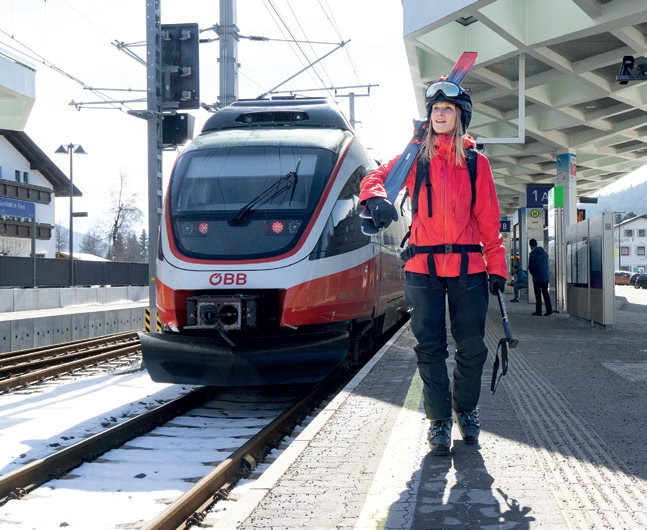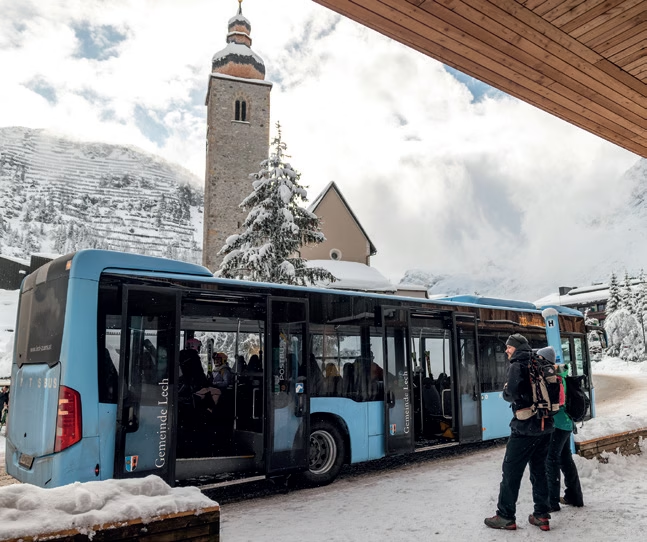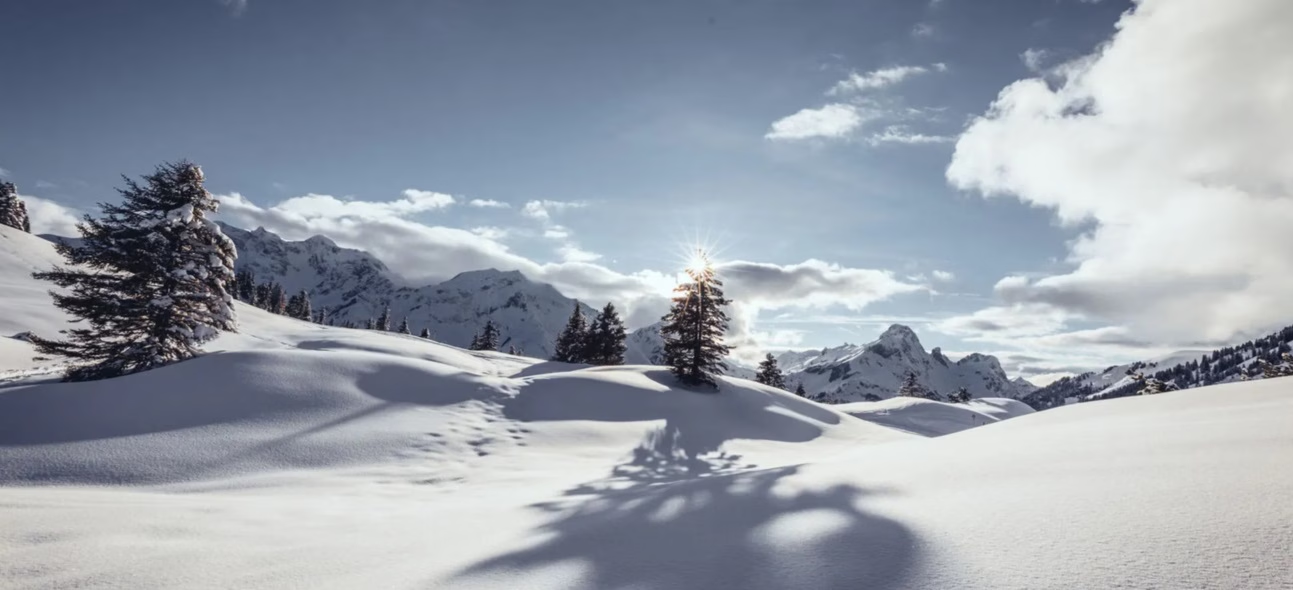His tracks in the fresh snow are enough to leave behind a significant (CO2) footprint. Public transport options are available, but train travel to winter sports destinations could be used more frequently. Even if new ideas and financial investment have recently been scarce.
New in Salzburg The Guest Mobility Ticket has been available since 2025. With this new ticket, all overnight guests can use all public transport in SalzburgerLand for the duration of their stay. This includes all city transport, regional bus services, all S-Bahn trains, regional trains, long-distance trains, and the Salzburg Verkehr shuttles within the province. Guests receive the ticket digitally in their wallet or as a PDF directly at check-in or pre-check-in at their accommodation. This means it can also be used from the Salzburg provincial borders upon arrival. The guest tax was increased by €0.50 to cover the cost of this offer. Consequently, there is currently no comparable mobility offer available.

A certain pioneering role Nevertheless, one has to give credit to Vorarlberg. Its ski resorts are not only easily and conveniently accessible by bus and train, but winter sports enthusiasts also benefit financially when traveling by public transport. Many ski resorts offer discounts on day tickets with the public transport ticket. And for those who already have a ski pass, in many cases the ski pass also serves as a ticket for trains and buses. Even at the ticket offices of numerous Vorarlberg ski resorts, people who have arrived by public transport benefit.
Train to the railway. Overall, the number of mountain lifts located directly next to a major train station is manageable: Bad Gastein, St. Anton am Arlberg, Zell am See, Schladming, Mayrhofen, and Semmering are among the larger areas where you can walk from the train station to the lift. Others are located at smaller train stops, such as Kitzbühel-Hahnenkamm or Annenheim-Gerlitzen. Most other regions offer free bus transfers. In addition to the Austrian Federal Railways (ÖBB), there are now more frequent daytime connections from eastern Austria on the Westbahn railway, which passes through the most important ski hubs on its way to Feldkirch. There are also small, local railways, such as the "Himmelstreppe" (Stairway to Heaven) for the Mariazell region or the Zillertalbahn.
Deutsche Bahn, not exactly known for its infrastructure shortcomings, has pulled off a coup with "WinterRail." Of the approximately 100 destinations offered, the majority are in Austria. Almost all the major ski resorts in Vorarlberg, Tyrol, and Salzburg are included in these packages, but Upper Austria, Styria, and Carinthia are also represented. Overall, rail travel to winter sports destinations, especially from Germany, has improved significantly. What WinterRail is for guests from Germany, "Im Nightjet zum Schnee" (On the Nightjet to the Snow) is for ski fans from eastern Austria. Railtours focuses on connections to Tyrol with these combination tickets. In addition to train travel on the ÖBB Nightjet, including seat reservation, the packages include a ski pass for either three to six days. Transfers to and from accommodation are also included. Upgrades to a 4- or 6-berth compartment in a couchette car are, of course, possible, provided you book early enough during peak season.

© Lucas Tiefenthaler – Vorarlberg Tourism
The shuttle The Zell am See-Kaprun region generally offers direct access to hotels. The ÖBB 360° shuttle service transports train passengers from the station to one of the region's approximately 600 accommodations. Shuttles can be booked up to 48 hours in advance, both online and at the ticket counter. This service is also available in the Gastein Valley, where they are particularly proud of their diverse options. For example, car sharing with six electric vehicles is offered at various locations at very reasonable rates. Thanks to the Guest Mobility Ticket, valid throughout Austria, it's also possible to transfer directly from the train to the ski lift. The Pillersee Valley has seen similarly positive developments, where a car-free vacation is now much easier than one might expect given its geographical location. Locally, guests can use the guest card to access public transportation. A free shuttle service to and from the train station is also offered there. For decades, the mountain railways and regions have been encouraging guests to leave their cars in the hotel garage at their holiday destination by providing free ski bus systems. Free ski buses were originally invented to alleviate parking shortages at ski lifts. They are usually financed in varying proportions by the municipalities, tourism organizations, and cable car companies. Today, they primarily serve to reduce traffic congestion – and their reach is constantly expanding. The 241-kilometer ski bus network in the Salzburg Sports World likely represents the record. On the other hand, Kitzbühel is convinced it has "the largest ski bus network in the Alps." Werfenweng offers a different form of alternative, local mobility. This award-winning municipality, a member of the "Alpine Pearls," provides the SAMO Card (for "Sustainable Mobility").
The e-Liner has been serving as an environmentally friendly means of transport at Wildkogel for five years now. With the e-Liner, skiers are transported "green and quietly" from the end of the valley run in Neukirchen back to the valley station of the Wildkogelbahn cable car.
E-mobility Electric mobility isn't just a topic of discussion in other regions due to the e-Liner and electric ski buses. For many travelers, the availability of charging stations on-site is also a key concern. To at least increase the share of electric vehicles, numerous lift companies are installing charging stations in their lift garages. Examples include Ischgl, Pitztal, Obertauern, and Schladming. Meanwhile, almost all main stations of major gondola lifts in the valleys now have numerous charging points. Perhaps the most spectacular of these can be found in Montafon. The garage at the Valisera valley station in St. Gallenkirch, the central access point to the Silvretta Montafon ski area, has been equipped with 50 charging stations. At Nassfeld, as in the Gastein Valley and Kitzbühel regions, there are around 40 charging stations. A unique feature in Carinthia is the FRED e-carsharing system.
